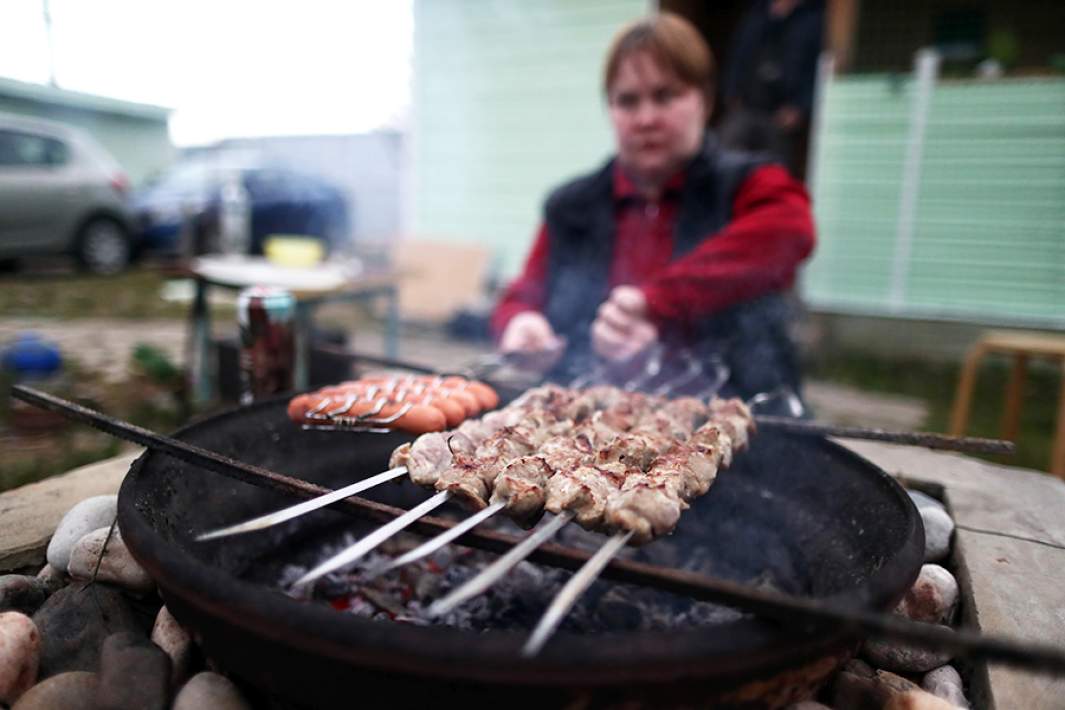The season of allergies caused by flowering plants has begun in Russia. And this year it may be difficult due to “pollen storms” – an excessive number of grains in a cubic meter of air. Izvestia found out how allergy sufferers can protect themselves in the spring, why it is important to undergo treatment and follow preventive measures, and why reactions occur in general.
Allergy season
Allergy season caused by flowering plants has begun in Central Russia. And this year it may not be easy, allergists warned. Due to the fact that the winter was snowy and wet, so-called pollen storms may occur, Natalya Ilyina, director of the Russian Association of Allergists and Clinical Immunologists (RAACI), spoke about this at a press conference at the Izvestia Medical Center.
— At this time, the number of pollen grains per cubic meter goes beyond all so-called possible norms. But during the peak of pollination (it lasts about 14 days), the wind rose may change or rains may begin – this will reduce pollen activitysaid the expert.
According to the chief allergist of the Central Administrative District of Moscow, Associate Professor of the Department of Pediatrics of the Pediatric Faculty of the Russian National Research Medical University named after N.I. Pirogov Anita Denisova, The dusting season in the middle zone began at the end of March – the alder and hazel trees bloomed. In the next few days, due to the warm weather, the concentration of their pollen will reach high levels, but the most pronounced complaints from patients will arise in mid-April, when the birch tree blooms.
— The south of the country is characterized by very aggressive flowering of ragweed, which will begin in mid-summer and continue until mid-autumn. The exact timing is quite difficult to predict; it all depends on the temperature, climate and amount of precipitation,” the doctor added.
As the allergist noted, Over the past few years, a more severe course of hay fever has been observed in Russia. This is due to climate change to a warmer one – because of this, the dusting season is extended and the amount of pollen increases. At the same time, the number of people suffering from allergic diseases is growing.
“This is already associated with a number of factors, such as urbanization, changes in diet, and excessive use of antibiotics. We see an increase in the prevalence of allergic diseases in both adults and children,” Izvestia’s interlocutor emphasized.
In the spring, doctors advised allergy sufferers to be especially careful – try to spend less time outside (you can go out wearing a mask), do not ventilate apartments and offices, and take antihistamines.
What is an allergy
An allergy is a pathological reaction of the immune system in which the body perceives certain substances that are safe for people as dangerous. This could be food, animal dander, dust, or plant blooms—as is the case with those who suffer in the spring.
As Lyubov Stankevich, director of laboratory medicine and production of the LabQuest laboratory, candidate of medical sciences, explains, Usually the appearance of an allergy is a predetermined event. If a person was born with a tendency to it (and this can happen if at least one of the parents suffers from allergies, because the number of allergy sufferers in the world is constantly growing), then when encountering an irritant, a reaction will develop with a high probability.
– On the one hand, there is a family history – the genetic cause of the appearance of allergies. On the other hand, no mutation or presence of a specific gene indicates this. Allergy is a condition that occurs when several factors coincide, says Izvestia’s interlocutor.
Historically it is believed that allergies have appeared since the beginning of human consumption of meat. Accordingly, people began to encounter parasites, and the immune system gradually learned to cope with them through the development of a protective mechanism in the form of immunoglobulin, different from IgG (the main proteins of the immune system): IgE appeared – an indirect immune response.
This reaction helped protect people from parasites, but subsequently some people began to experience the same immune response to stimuli unrelated to parasitic infestations. In fact, this distorted reaction is the modern allergy that people experience today.
“Any reaction begins with sensitization of the first “acquaintance” of our immune system with the allergen, the result of which is an increase in cellular sensitivity and the production of IgE class antibodies specific to the irritant,” says Stankevich. — At the same time, the path through which the allergen entered the body is also important; “acquaintance” does not always occur immediately after consuming the product, inhaling it or getting it on the skin. But the likelihood increases significantly if natural protective barriers, such as the nasopharyngeal or intestinal mucosa, are damaged.
Why allergies occur
As the expert explains, Two immunoglobulins are responsible for the immune response in humans – IgG and IgE. And the human body knows how to “switch” between them when reacting to different allergens.
— The principle of allergy treatment is based on this mechanism – if you force the use of IgG instead of IgE, then you can symptomatically cure the allergy and “wean” the body from further reacting to the allergen in a harmful way. This is called allergen-specific therapy (ASIT), and in the future it can treat any allergy, says Lyubov Stankevich.
Similar processes sometimes occur in natural conditions. For example, there is a theory that children born into families with pets are less likely to develop allergies to them because babies are exposed to allergens from birth and gradually train their system to respond with a normal IgG response. On the other hand, if the body is quickly overloaded with an irritant, then theoretically this could cause a malfunction in the immune system and switch the reaction to an IgE response.
— Unfortunately, it is impossible to completely eliminate contact with potential allergens. They are found literally everywhere: in food, cosmetics and even clothing fibers. But here it is important to dwell on the violation of the integrity of protective barriers, for example mucous membranes – smokers are especially successful in destroying them. By the way, smoking by the mother in the first year of the child’s life or his birth during the pollen season becomes one of the risk factors for the development of allergies in the child, says the candidate of medical sciences.
Another important barrier that can protect against allergies is the liver, which inactivates and binds toxins in the body. And if this process is disrupted, then the organ can easily pass large molecules – and the larger the particle, the more allergenic it is. At the same time, the expert notes, it is not difficult to worsen the condition of the liver – uncontrolled use of antibiotics is enough, which is extremely common in everyday life as a universal remedy for treating colds.
Finally, The third risk factor for the development of allergic reactions is the emergence of new synthetic food products, creams and paints. Thus, humans add new allergens to the galaxy of those already existing in nature.
“And here barriers come into play again: if the intestines and liver can effectively break down the synthetic “guest,” then it will probably not be able to come into contact with the immune system and provoke an allergy,” says Lyubov Stankevich.
Also, in some cases, a person may develop an allergy to medications. But sometimes doctors are faced with a false alarm – the reaction may not be caused by the medicine itself, but by the components of the tablet or capsule, the shell and dyes.
Spring problems
In spring, people especially often suffer from allergic rhinitis, that is, a runny nose. During flowering, a huge amount of plant pollen is formed in the air, which can be carried by the wind and subsequently settle on furniture and interior items – therefore, allergy sufferers suffer even while staying at home.
At this time, other household allergens should not be discounted: house dust, mites, cat epithelium and dander, cow's milk. In addition, other foods can cause a reaction: fresh stone fruits, nuts, herbs, honey, kvass and various spices that many people add to food.
— Some allergy sufferers are advised to start taking anti-allergy medications before the start of the season. But you shouldn’t do this without recommendations: Firstly, you first need to identify exactly what you are allergic to. Now for this you can undergo a comprehensive analysis using the allergy chip method – this test allows you to detect the presence of IgE antibodies to almost 300 allergens in one blood drawsays Lyubov Stankeich.
Secondly, she adds, only a physician can use the results to determine whether appropriate allergen-specific immunotherapy exists. To date, ASIT therapy has been developed for birch, some herbs and plants, cat allergens, house dust mites and certain molds. However, ASIT therapy is not carried out at the time of flowering.
In any case, doctors advise trying to reduce the number of contacts with allergens. Regular wet cleaning and getting rid of “dust collectors” at home: old toys, sofa cushions (it’s better to change them from time to time) and other things can help with this.
In addition, allergist Madina Shadyzheva of the FMBA of Russia recommends that everyone who suffers from seasonal allergies should use air purifiers and humidifiers at home (and, if possible, at work), and when returning from the street, be sure to take a shower and rinse your sinuses with salt water. Clothing after going outside should at least be cleaned with a brush, or better yet, washed immediately.
#Don39t #leave #room #allergy #season #begun #Russia





